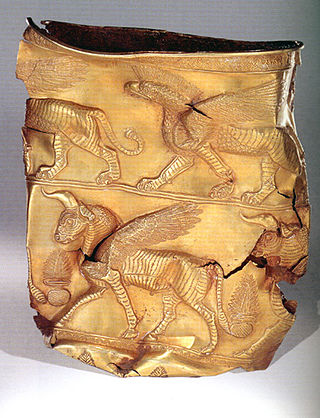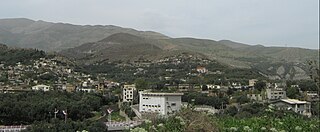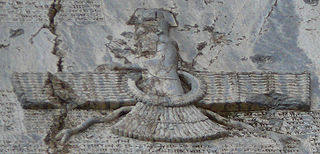
Ecbatana was an ancient city, which was first the capital of Media in western Iran, and later was an important city in Persian, Seleucid, and Parthian empires. It is believed that Ecbatana is located in the Zagros Mountains, the east of central Mesopotamia, on Hagmatana Hill, an archaeological mound in modern Hamedan in Zagros mountains.

Mazandaran province is one of the 31 provinces of Iran, located along the southern coast of the Caspian Sea and in the adjacent Central Alborz mountain range, in central-northern part of the country. The province covers an area of 23,842 km2. It was founded in 1937.

Khuzestan province is located in southwestern Iran. Its history extends from the pre-Aryan ancient Elamite civilization to the modern-day Islamic Republic.

The Cadusii were an ancient Iranian tribe that lived in the mountains between Media and the shore of the Caspian Sea. The area that the Cadusii lived in bordered that of the Anariacae and Albani. The Dareitai and Pantimati people may have been part of the Cadusii.
The Jiroft culture, also known as the Intercultural style or the Halilrud style, is an early Bronze Age archaeological culture, located in the territory of present-day Sistan and Baluchestan and Kermān Provinces of Iran.
Ezatollah Negahban was an Iranian archaeologist known as the father of Iranian modern archaeology.
Sutkagan Dor is the westernmost known archaeological site of the Indus Valley civilization. It is located about 480 km west of Karachi on the Makran coast near Gwadar, close to the Iranian border, in Pakistan's Baluchistan Province. The site is near the western bank of the Dasht River and its confluence with a smaller stream, known as the Gajo Kaur. It was a smaller settlement with substantial stone walls and gateways.

Marlik is an ancient site near Roudbar in Gilan, in northern Iran. Marlik, also known as Cheragh-Ali Tepe is located in the valley of Gohar Rud, a tributary of Sepid Rud in Gilan Province in Northern Iran, Marlik. Marlik is the site of a royal cemetery, and artifacts found at this site date back to 3,000 years ago. Some of the artifacts contain amazing workmanship with gold. Marlik is named after the Amard people.

Rudbar is a city in the Central District of Rudbar County, Gilan province, Iran, serving as both capital of the district and of the county.

The Amardians, widely referred to as the Amardi, were an ancient Iranian tribe living along the mountainous region bordering the Caspian Sea to the north, to whom the Iron Age culture at Marlik is attributed. They are said to be related to, or the same tribe as, the Dahae and Sacae. That is to say, they were Scythian. Herodotus mentions a tribe with a similar name as one of the ten to fifteen Persian tribes in Persis.

Padishkhwārgar was a Sasanian province in Late Antiquity, which almost corresponded to the present-day provinces of Mazandaran and Gilan. The province bordered Adurbadagan and Balasagan in the west, Gurgan in the east, and Spahan in south. The main cities of the province were Amol and Chalus.

Zayandeh River Culture is a hypothetical pre-historic culture that is theorized to have flourished around the Zayandeh River in Iran in the 6th millennium BC.

Mohammad-Vali Khan, Khalatbari Tonekāboni, known as Sepahdar A'zam, was the leader of the constitutionalist revolutionary forces from Iran's Northern provinces of Gilan and Mazandaran and known as one of the greatest statesmen and military commanders of Persian history as well as its wealthiest nobleman.
Yousef Majidzadeh is an Iranian archaeologist and director of the excavations at Ozbaki, Qabristan and Jiroft. He is a native of Tabriz.

The prehistory of the Iranian plateau, and the wider region now known as Greater Iran, as part of the prehistory of the Near East is conventionally divided into the Paleolithic, Epipaleolithic, Neolithic, Chalcolithic, Bronze Age and Iron Age periods, spanning the time from the first settlement by archaic humans about a million years ago until the beginning of the historical record during the Neo-Assyrian Empire, in the 8th century BC.

Gīlān is an Iranian province at the southwestern coast of the Caspian Sea. This articles discusses its history.

Seifollah Kambakhshfard was an Iranian archaeologist, who specialized in archaeology and Ancient History of Iran.
Tālīsh is a historical and geographical region near the southwestern coast of the Caspian Sea, an area of compact residence of the Talysh people. It got its name from the ethnonym of the Talysh people inhabiting it.

The Gelae, or Gelians, were a Scythian tribe mentioned by Strabo and other ancient writers as living on the southern shores of the Caspian Sea. The name of the province Gilan might possibly be derived from the Gelae. Another hypothesis held by several historians, suggests that the Gelae are equivalent to the Galgai, the ancient neighbours of the Legae (Leks).














